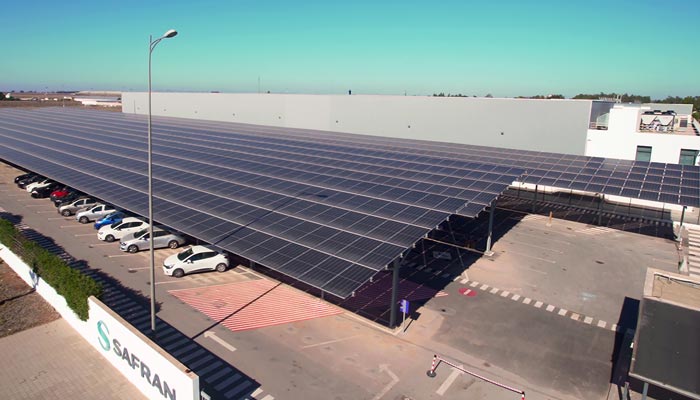Paris, February 1st, 2023
Safran, working with Réservoir Sun and Idex, will generate part of the energy it uses by installing solar panels at 17 of its sites in France.
With a total capacity of almost 50 MWp,1 the photovoltaic arrays will be installed mainly on parking lot shade structures and will cover a total area of just under 180,000 square meters (1.9 million sq.ft). Approximately 39 GWh (gigawatt hours) per year will be generated for self-consumption at the sites and will cover an average of 15% of their requirement.
“Safran continues to implement its action plan to achieve its environmental targets and is installing photovoltaic panels at its French sites, working with partners Réservoir Sun et Idex, who are experts in this field,” said Thibaud Normand, Safran’s Vice President Climate.
Installation work managed by the two partner companies will begin this year and will continue through to the first quarter of 2025. The Safran Nacelles industrial facility in Gonfreville-l’Orcher (Normandy) will be the first site to come on stream, in June this year. The system at Safran Aircraft Engines in Évry-Corbeil (near Paris) will be one of the largest self-consumption PV arrays on any industrial site in France. A second phase will later be launched to install solar arrays at more than 40 Safran facilities in France.
Safran is pursuing the same initiative in the rest of the world, with PV installation projects completed or planned at its sites in Australia, Belgium, China, Malaysia, Mexico, Morocco, Singapore, Thailand, Tunisia and the United Kingdom. Systems generating a total of almost 24 MWp have been or are being installed for self-consumption.
Rollout of these PV systems is part of Safran’s broader strategy to reduce its carbon footprint. The objectives of this strategy have recently been validated by independent body the Science Based Targets initiative (SBTi). Safran is committed to a 50.4% reduction in its Scope 1 (direct) and Scope 2 (indirect) emissions related to the energy consumption of its operations by 2030, compared to a 2018 baseline.












Be the first to comment on "Safran Solar energy production"